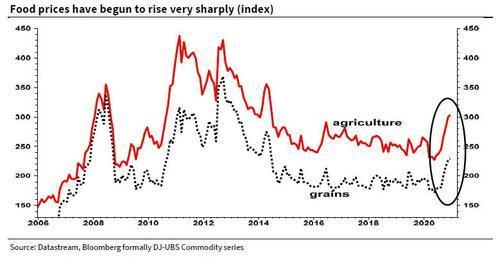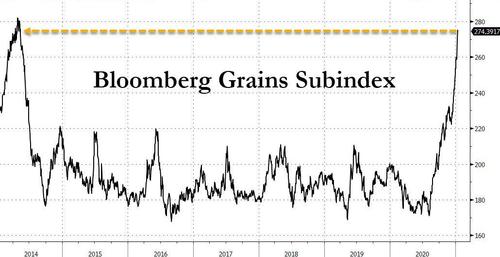Kraft Heinz, Conagra Will Start Passing On Soaring Food Costs To Consumers
Stagflation for the masses?
Cost of living is about to soar and all the average joe has to cover it is a $1400 check from Uncle Joe.
Late last year we noted that SocGen’s Albert Edwards warning readers that it could be time to start “panicking” about soaring food prices.
Edwards’ research said, “keep a very close eye as to whether we see a repeat of the 2010/11 surge in food prices” because “on the 10th anniversary of the start of the Arab Spring, and with poverty having already been made much worse by the pandemic, another food price bubble could well be the straw to break the very angry camel’s back.”
While it’s not quite the spring of 2021 just yet, there are indications that soaring food costs are about to get passed on to consumers – this is terrible news for working-poor folks who are already suffering from housing and food insecurities.
According to Reuters, Kraft Heinz Co and Conagra Brands Inc warned Tuesday that price increases of wheat, sugar, and other commodities are becoming more expensive due to elevated demand.
Conagra executives told Reuters that increased prices for edible oils, pork and eggs, and packaging might force it to pass it along to consumers in the form of higher prices.
Kraft Heinz CEO Miguel Patricio said inflation is everywhere in the agri complex.
He said inflation in “everything related to grains” is being observed, and it may result in price increases of some categories, including mac and cheese and mayonnaise, later this year.
Is it time to worry about food inflation?
According to Edwards, the answer is “yes.”
In December’s CPI print, food inflation was very notable on Jan. 13. The report said:
The food at home index increased 3.9 percent over the past 12 months. All six major grocery store food group indexes increased over the period. The largest increase was the meats, poultry, fish, and eggs index which rose 4.6 percent as the beef index increased 5.3 percent. The smallest increases were for the cereals and bakery products and the fruits and vegetables indexes, which both increased 3.2 percent over the last 12 months. The index for food away from home rose 3.9 percent over the last year. The index for limited service meals rose 6.0 percent and the index for full service meals rose 3.0 percent over the span.
Also, the Food and Agriculture Organization’s Food Price Index rose for a seventh consecutive month in December, led by dairy products and vegetable oils.
So, as the surge in global food prices remains anything but transitory, major food producers are set to pass on those food costs for consumers at a time when millions of them can barely afford rent and or feed their families.
Of course, while food prices are surging around the world, the well-managed signals in official inflation data remains relatively low… enabling central planners to keep the spigots wide open (no matter what the consequences).
As we noted previously, while central bankers walk around with their heads in the clouds, a team at C+R Research has surveyed more than 2,000 American consumers to find out how they have “adjusted” to these higher prices, which have come amid a surge in unemployment. Their findings aren’t all that surprising: 85% of consumers said that their budgets had been impacted by having to pay more for groceries. Milk, eggs and meat are the top staples that Americans are paying more for.
And given the headlines today, things are about to get even worse.
To sum up, prepare for major food companies to start jacking up food prices. We assume this will not sit well in the stomachs of already-broke consumers.
Tyler Durden
Tue, 02/16/2021 – 18:50![]()
Zero Hedge’s mission is to widen the scope of financial, economic and political information available to the professional investing public, to skeptically examine and, where necessary, attack the flaccid institution that financial journalism has become, to liberate oppressed knowledge, to provide analysis uninhibited by political constraint and to facilitate information’s unending quest for freedom. Visit https://www.zerohedge.com



